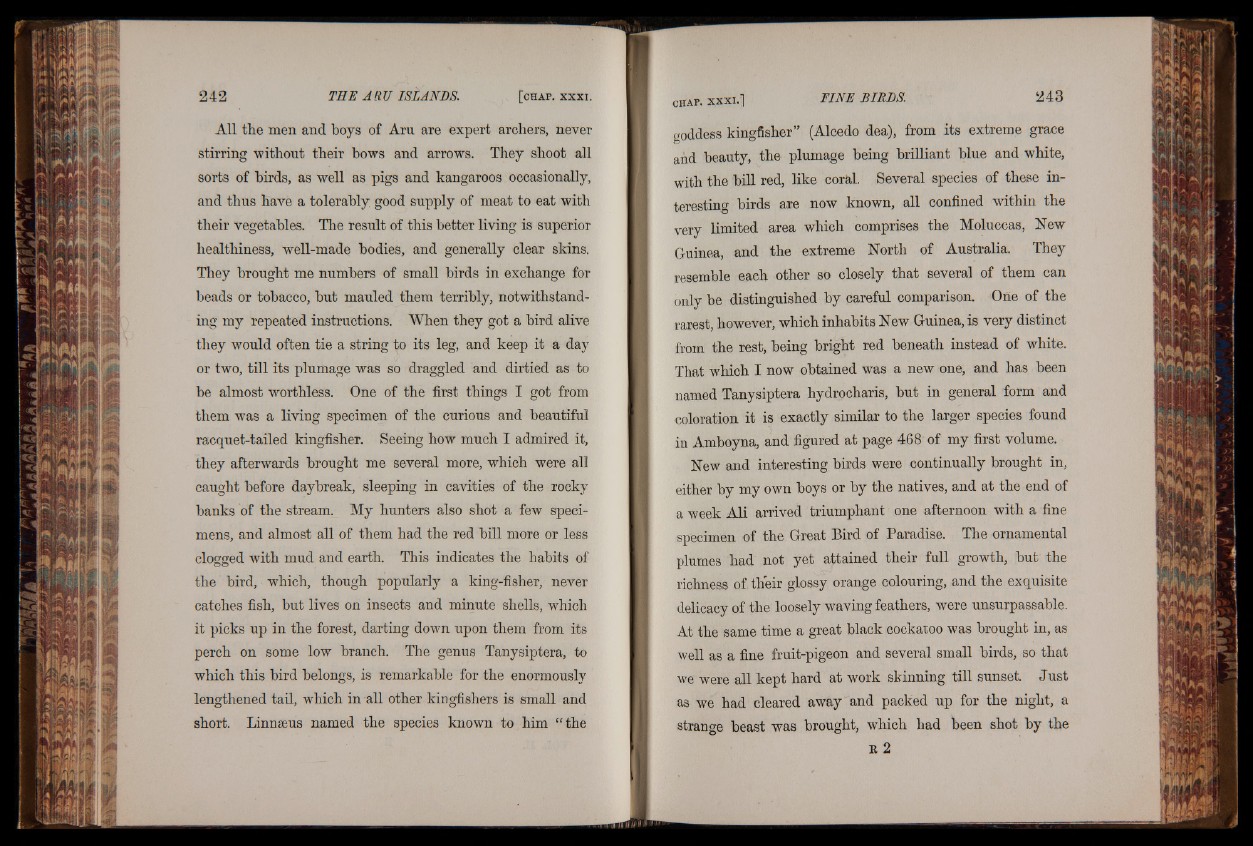
All the men and boys of Aru are expert archers, never
stirring -without their bows and arrows. They shoot all
sorts of birds, as well as pigs and kangaroos occasionally,
and thus have a tolerably, good supply of meat to eat with
their vegetables. The result of this better living is superior
healthiness, well-made bodies, and generally clear skins.
They brought me numbers of small birds in exchange for
beads or tobacco, but mauled them terribly, notwithstanding
my repeated instructions. "When they got a bird alive
they would often tie a string to its leg, and keep it a day
or two, till its plumage was so draggled and dirtied as to
be almost worthless. One of the first things I got from
them was a living specimen of the curious and beautiful
racquet-tailed kingfisher. Seeing how much I admired it,
they afterwards brought me several more, which were all
caught before daybreak, sleeping in cavities of the rocky
banks of the stream. My hunters also shot a few specimens,
and almost all of them had the red bill more or less
clogged with mud and earth. This indicates Oo the habits of
the bird, which, though popularly a king-fisher, never
catches fish, but lives on insects and minute shells, which
it picks up in the forest, darting down upon them from its
perch on some low branch. The genus Tanysiptera, to
which this bird belongs, is remarkable for the enormously
lengthened tail, which in all other kingfishers is small and
short. Linnseus named the species known to him “ the
goddess kingfisher” (Alcedo dea), from its extreme grace
and beauty, the plumage being brilliant blue and white,
with the bill red, like coral. Several species of these interesting
birds are now known, all confined within the
very limited area which comprises the Moluccas, New
Guinea, and the extreme North of Australia. They
resemble each other so closely that several of them can
only be distinguished by careful comparison. One of the
rarest, however, which inhabits New Guinea, is very distinct
from the rest, being bright red beneath instead of white.
That which I now obtained was a new one, and has been
named Tanysiptera hydrocharis, but in general form and
coloration it is exactly similar to the larger species found
in Amboyna, and figured at page 468 of my first volume.
New and interesting birds were continually brought in,
either by my own boys or by the natives, and at the end of
a week Ali arrived triumphant one afternoon with a fine
specimen of the Great Bird of Paradise. The ornamental
plumes had not yet attained their full growth, but the
richness of their glossy orange colouring, and the exquisite
delicacy of the loosely waving feathers, were unsurpassable.
At the same time a great black cockatoo was brought in, as
well as a fine fruit-pigeon and several small birds, so that
we were all kept hard at work skinning till sunset. Just
as we had cleared away and packed up for the night, a
strange beast was brought, which had been shot by the
E 2